American couturier Abraham Pelham recently passed away in Paris. In what many would consider to be an ostensibly unlikely career path he became the first black designer to gain critical acclaim and international notoriety as an esteemed Parisian couturier.
Born on March 16, 1956 in Monrovia, Liberia, Abraham Pelham learned early in life: know what you want and fight to get it, through hard work. Sharply intelligent his astuteness would serve beyond measure over the years.
After high school, he studied at the prestigious F.I.T. (Fashion Institute of New York) and, upon graduating, he went to work for famed American fashion house, Bill Blass. It was here that he honed his already considerable technical talents and where he developed his own aesthetic code that would be defined by his love of pure lines, volumes and geometry. These element would be the precursors to his couture’s DNA.
In 1997 Pelham took a leap of faith, that would see him making his biggest moves ever in achieving his ultimate goal. He sold all his belongings, gave up his apartment, in New York City, and moved to Paris to pursue his dream of becoming a couturier.
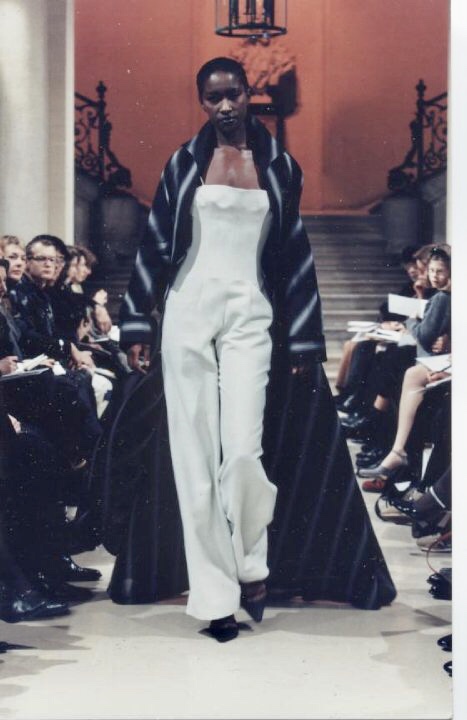
It would have been easy to dismiss the huge ambitions of Abraham Pelham, particularly after he loudly announced he wanted to become a member of the Chambre Syndicale de la Haute Couture, the body that governs France’s haute couture establishments, and he certainly did not fit the image of any of the Parisian couturiers of the day. He was African-born and both mentally and culturally American and, of course, he had an obvious physical challenge that made it easy for others to underestimate his drive.
At the time the Chambre Syndicale de la Haute Couture was very different from today. It did not have an overt policy of openness with the official haute couture calendar bring dominated by huge names like Yvès Saint Laurent, Christian Lacroix, Chanel, Christian Dior, Valentino, Givenchy, Torrente, Hanae Mori, Emanuel Ungaro, along with Dominique Sirop and Olivier Lapidus.
The calendar simply did not look welcoming to outsiders. Even with the exception of the legendary Japanese grand couturier, Hanae Mori, the French grand couturier Madame Rose Torrente-Mett and Adeline André, the Federation’s official calendar looked entirely like an exclusive, old-school, country club for privileged white boys.
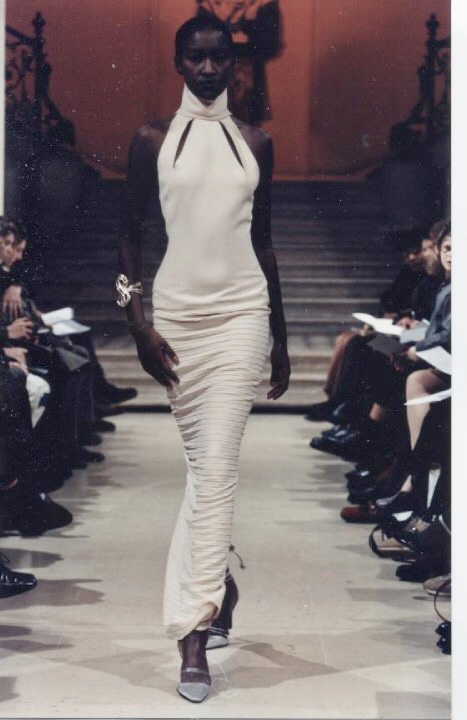
However, Pelham was determined to shake things up, and he did! He quickly made friends and allies in Paris as soon as he arrived. Becoming acquainted with Josiane Lécéfel – the legendary, hard-nose shopper for the fashion division of France’s Gala Magazine – was a pivotal step. After inviting her to visit him, to see his work, he would soon get his first recognition from a major French publication and in fashion spreads alongside top names such as Prada, Yves Saint Laurent, Chanel, and Guy Laroche.
“I met Abraham Pelham at a fashion show in the Ivory Coast,” said Josiane Lécéfel of her first acquaintance with the couturier. “Once back in Paris, I visited him at his home-atelier at the Colonel Fabien Square. I looked at all the garments and choses a few items. At that time it was very difficult to even promote a black designer in Paris fashion. So, back at the magazine, I just put Pelham’s garments in with the rest of other clothes that were being considered for Gala’s upcoming fashion spreads. Later, when the stylist, Dominique Flageolet, showed up to pick out clothes for a photoshoot, that would take place in Africa, she asked who made the items when she saw Pelham’s work. I simply said that a designer had dropped them off for consideration. And that was that. Dominique loved the pieces because of their quality and because they fit the theme. She took two items from the five that I had put on the clothes rack… and the rest, as they say, was history.
Weeks later, in early 1998, I was in bed when my phone rang at 6:00am in the morning. Thinking it was surely an emergency, I answered. When I did, it was Abraham. He was screaming at the top of his lung ! I did not understand anything he was saying. Then I realized that his garments made it into the magazine and his screams were beautiful cries of joy!
I was happy for him. It was the first time that his creations were featured in an important French publication. I am glad that I was able to play a small role on his path to happiness.”

It was early in spring 1998 that Pelham hit a stumbling block and it was the legendary, 80’s runway supermodel, Katoucha, who came to his aid by sending him the young and ambitious press attaché Philippe Angelotti. With Angelotti by his side Pelham was able to quickly move forward with the next step of his plan to upset the Paris haute couture establishment.
Over the following weeks and months, he worked tirelessly to prepare his first couture show. He put together a motley crew of inexperienced yet eager and dedicated helpers who picked up the slack by running countless small but important errands. He hired future designer, Jean-Marc Benoit, initially as his pattern maker and then as premier d’atelier. He interviewed production teams, found the venue, planned his castings, the music, and everything in-between.
Of that period, and on the passing of his mentor, Jean-Marc Benoit say, “A friend notified me. I was in shock. But that shock took me back to the old days of the very beginning of my adventure with Abraham.”
Benoit, who is the founder of the JMB fashion brand, speaks fondly of his time with his mentor and friend. He went on to say, “I stayed with Abraham for 10 years. I had barely graduated from school when I started with him. I helped Abraham with the creation from fabrication of the clothes to the organization of the clothes. Together we spoke the same language and shared the same vision. Yes, we clashed at times over technique but it was so great because that is what created the results. This was essential as we headed towards that very first show.
Abraham had a strong character. He was a master technician who understood true couture technique and I learned how to do my job with him. He taught me to see fashion through his own eyes.
His approach was modern and resolutely American but respectful to the tradition of haute couture. Working with him was challenging because I had studied a more classical approach, at the Ecole de la Chambre Syndicale, but Abraham Pelham taught me MODERNITY!”
As his first show approached Pelham and his team worked feverishly to finish the designs, perfect the patterns and match fabrics to garments. Then came the fittings, the castings, and the finalization of the collection. They also managed to create the invitations, select the music, plan the seating arrangements and book the caterers. And, of course, he had to battle each step of the way to find the financing for the adventure.
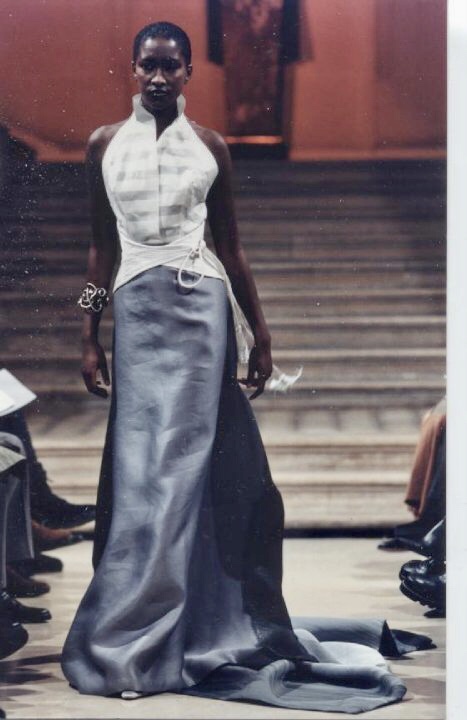
On Saturday, July 18, 1998, Abraham Pelham’s dream of becoming a recognized international, Paris-based couturier became reality.
It was a beautiful, warm day, with clear skies. It was also day of important firsts; Jean-Paul Gaultier presented his first couture collection. Donatella Versace showed her first work for the Atelier Versace couture line after the tragic death a year earlier of her brother Gianni Versace. And it was Pelham’s first moment of glory in Paris.
The show took place at the grand hall of the Crédit Foncier bank, just off of Place Vendôme, in the heart of chic Paris. Josephine Baker was the collection’s theme and Katoucha opened and closed the show. Among the curious media to attend were famed fashion critic, Suzy Menkes, of the International Herald Tribune and Madeline Czeigler, producer of Fashion File, the world’s biggest television program on fashion. It was a great moment to be alive.
Once the magical 20 minutes of show ended came the applause. But what did it really mean? Was the applause the standard polite tip of the hat to the couturier who had invited the press? Or was it a real sign of the appreciation for his work?
Two days later, on Monday, July 20th the answers came rolling in. Suzy Menkes gave the collection a very strong review. A rarity from the most powerful woman in European fashion at the time. In addition, she honored Pelham’s work by placing a photo, from his collection, on the front page of the International Herald Tribune. It was an honor that not even 20% of the official haute couture houses received that summer.
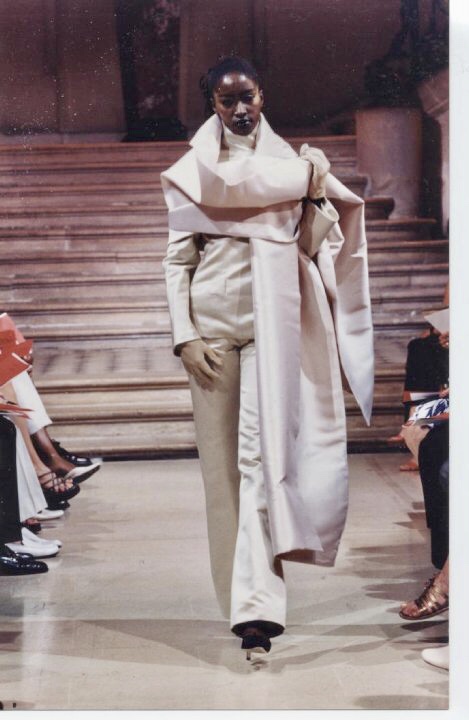
Abraham Pelham’s name became one of the hottest new names on the Parisian couture scene, in great part, thanks to the unique blessing bestowed on him by Suzy Menkes. Each season thereafter would bring more press, more interviews and more coveted recognition from his peers. Top editors sat front row alongside television channels and major newspapers and, as their numbers grew, so did the accolades for the couturier’s talent.
As his fame blossomed so did the legend around his skills as a master technician with an eye for the rarest details. He reinforced the image of his collections, built on pure lines, volumes, geometry, raffia, elaborate belts with long cords, hand-painted motifs on delicate fabrics, and the Pelham collar all imbued in mystery and subdued sensuality. These mounting accomplishments led the grand couturier, Olivier Lapidus, to sponsor Pelham’s petition to be granted an invitation to join the official haute couture calendar as an invited member.
Every six months, over a two and a half year period, Abraham Pelham staged show after show. He worked on themes for his couture collections that included a modern vision of Eve for the new millennium, the work of Jean-Michel Basquiat, and Gladiator.
Djariata Niang was one of the couturier’s favorite catwalk divas. She joined his cast of models when he cast her for his second fashion show. Reliable and professional to a fault he considered her a spiritual daughter. Upon learning of his passing, she cried. She recounted, with a voice full of emotion, details of her relationship with Abraham Pelham.
“There are not a lot of people who put heart and love into fashion,” said Niang “but Abraham was one who did.”
Giving details on how her relationship with Abraham Pelham started, Mlle. Niang says, “My agency sent me to a casting in an atypical place. When I arrived, he took me by the hand and smiled. He said, ‘Darling I love you. I have seen you in many shows on tv. I do not have the budget to pay you what you are normally paid. But I need you. Will you do the show for me? He gave me a dress to try on. It was a magical moment. That is how our relationship began. From that time, I found in him an artist with a soul and with softness. In him, I saw someone like Yves Saint Laurent. Like him, Abraham took the time to know you and the other models. We were not just living and walking clothes hangers for him. We were real people to him.”
Much to his credit, after Djariata Niang, the couturier cast other supermodels for his shows including Diana Gartner and Ling Tan.
His skill and creativity helped him to further develop his clientele which included Americans and Swiss but also a Saudi princess and the Nobel Peace Prize winner/President of Liberia, Ellen Johnson Sirleaf.
Though Abraham Pelham’s dream of becoming an invited member of the Chambre Syndicale of Haute Couture did not materialize he leaves behind a strong legacy. He walked a difficult path so that those who would follow could achieve the final steps his own dream and he did it long before the fashion world had ever heard of the notions of diversity and inclusion.
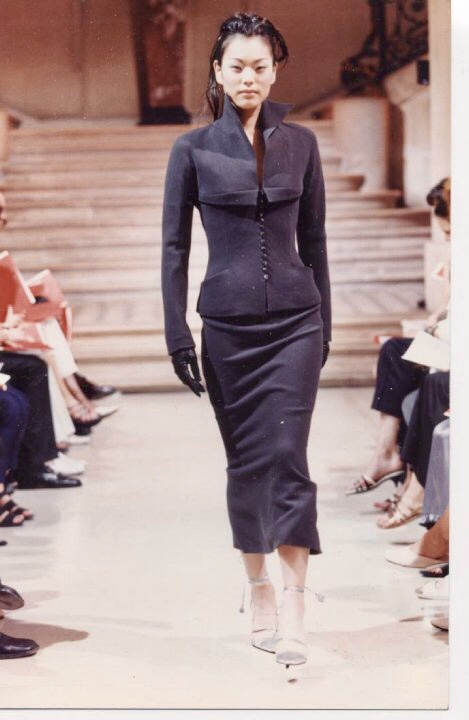
Since Abraham Pelham’s groundbreaking efforts the haute couture world has opened up to recognize the talents of well deserving and diverse talents such as Elie Saab, Zuhair Marad, Imane Ayissi and Georges Hobeika to name a few.
Without a doubt Abraham Pelham’s efforts put the necessary cracks in the doors through which the aforementioned couturiers would eventually walk through. That is his legacy. It is just as big as his unquestionable technique, as mesmerizing as the volumes of his ballroom skirts, and as enduring as the elegance and sober sensuality of his designs that took Paris and the international couture establishment by storm.
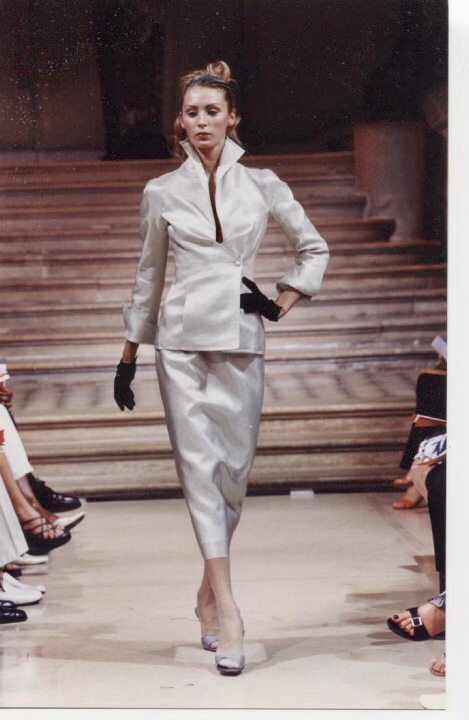
Photos Courtesy of Abraham Pelham Archives.

